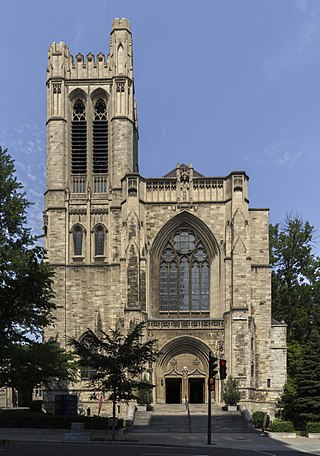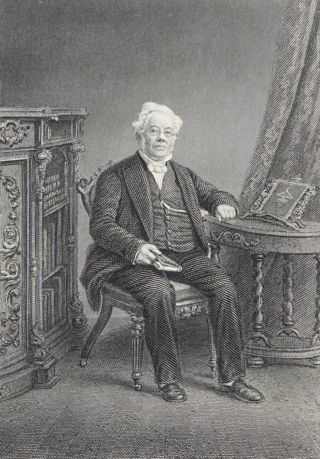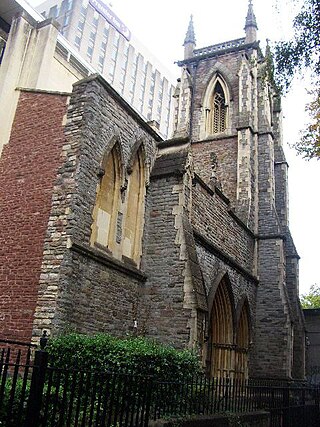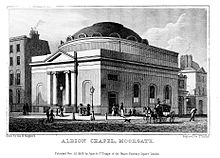The United Presbyterian Church (1847–1900) was a Scottish Presbyterian denomination. It was formed in 1847 by the union of the United Secession Church and the Relief Church, and in 1900 merged with the Free Church of Scotland to form the United Free Church of Scotland, which in turn united with the Church of Scotland in 1929. For most of its existence, the United Presbyterian Church was the third largest presbyterian church in Scotland, and stood on the liberal wing of Scots Presbyterianism. The church's name was often abbreviated to the initials UP.

The Church of Saint Andrew and St Paul is a Presbyterian church in downtown Montreal, Quebec, Canada. It is located at 3415 Redpath Street, on the corner of Sherbrooke Street. It is in close proximity to the Golden Square Mile, the Montreal Museum of Fine Arts, Concordia University as well as the Guy-Concordia Metro station.

The London Missionary Society was an interdenominational evangelical missionary society formed in England in 1795 at the instigation of Welsh Congregationalist minister Edward Williams. It was largely Reformed in outlook, with Congregational missions in Oceania, Africa, and the Americas, although there were also Presbyterians, Methodists, Baptists, and various other Protestants involved. It now forms part of the Council for World Mission.

Archibald Simpson was a Scottish architect, who along with his rival John Smith, is regarded as having fashioned the character of Aberdeen as "The Granite City".

St Mary Moorfields is a Roman Catholic church in Eldon Street near Moorgate, on a site previously known as Moorfields. It is the only Catholic church in the City of London. Prior to a 1994 boundary change, the church was in the Borough of Hackney, such that there were no Catholic churches in the City.

Finsbury Circus is a park in the Coleman Street Ward of the City of London, England. The 2 acre park is the largest public open space within the City's boundaries.

Alexander Fletcher (1787–1860), the Children's Friend, was a Scottish kirk minister, and later an Independent (Congregational) divine in England. Author of numerous devotional works, and founder of the Finsbury Chapel in London, he was widely acknowledged as the pioneer of preaching to audiences of children and attracting large crowds of young people to nonconformist chapels through specially designed events and services as well as through Sunday schools.

St. Andrew's Scots Church, sometimes known as the Church of Scotland, is a 19th-century church in Valletta, Malta. The church was built to the neo-Gothic design of Maltese architect Giuseppe Bonavia. It is still an active church today, as a joint congregation of the Church of Scotland, as part of the Presbytery of Europe, and the British Methodist Church South-East District.

Henry Cooke (1788–1868) was an Irish Presbyterian minister, an opponent of secularisation, and, in response to Catholic mobilisation under Daniel O'Connell, an advocate of "Protestant unity".

Robert Burns (1789–1869) was a Scottish theological writer and church leader.

St James' Presbyterian Church was a church in The Haymarket, St James, Bristol, England.

John Cunningham Geikie was a Scottish-born minister and author, primarily active first in Toronto, Canada, and then in England.
The Relief Church was a Scottish Presbyterian denomination founded in 1761. In 1847 it united with the United Secession Church to form the United Presbyterian Church of Scotland.

Finsbury Chapel, originally known as Fletcher's Chapel, was a Congregational chapel on the south side of East Street, Finsbury, London. It was founded by the Church of Scotland minister Alexander Fletcher in 1825.

John Nelson Goulty was an English Nonconformist Christian pastor. He is best known for his sermons against mandatory tithing to the Church of England and against colonial slavery. After early work at Nonconformist chapels in Godalming and Henley-on-Thames, he moved to Brighton where he became "one of the most important persons" in the 300-year history of the town's Union Chapel. He also helped to found schools and a cemetery in Brighton.
Events from the year 1815 in Scotland.
Thomas Simpson (1825–1908) was a British architect associated with the seaside town of Brighton. As architect to the Brighton and Preston School Board and the equivalent institution in neighbouring Hove, he designed "a distinguished group of board schools" during the late 19th century, when the provision of mass education was greatly extended. Many of these schools survive and some have listed status. He also worked on five Nonconformist chapels for various Christian denominations, using a wide variety of materials and architectural styles. He was the father of Sir John William Simpson and Gilbert Murray Simpson, who both became architects.
William McKerrow was a Scottish minister of the Presbyterian Church of England who had a particular interest in education. He lived for most of his life in Manchester, England, where he immersed himself in the radical politics prevalent there at the time.

George Lawson D.D. (1749–1820) was a Scottish minister of the Secession Church, known as a biblical scholar. Thomas Carlyle, in an 1870 letter to Lawson's biographer John Macfarlane, called him "a most superlative steel-grey Scottish peasant ".

James Tait FRIBA FRIBA was an architect based in Leicester.
















